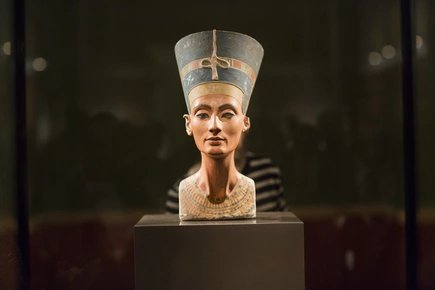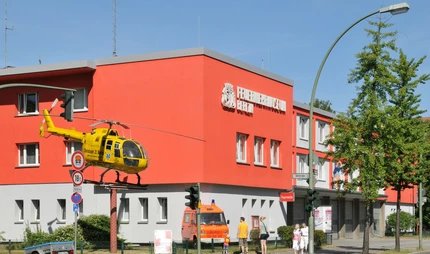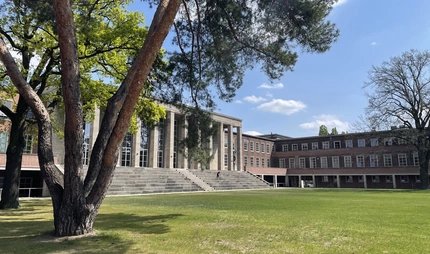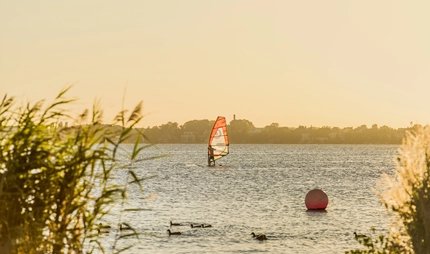
Wassersportmuseum Grünau (Water Sports Museum)
Tangible sporting history on the river bank
The Wassersportmuseum (Water Sports Museum) Grünau has been open again. The museum documents the history of water sports in Berlin.
The Water Sports Museum Grünau is located in the south-east of Berlin, on the former Olympic regatta site from 1936. It is an integral part of the Berlin Sports Museum and is dedicated to the rich history of water sports in Berlin and Brandenburg.
Grünau has been a historical centre of water sports - especially rowing - since the 19th century. From the first rowing clubs on the Dahme and Spree rivers to top-class sport. Grünau developed into an important regatta centre, which in 1928 was unique in Germany with over six starting lanes in a natural body of water.
The permanent exhibition in the Grünau Water Sports Museum takes you on a historical journey of water sports from its beginnings to the present day and sheds light on the development of boating techniques, physical techniques and water sports clubs. You will also gain an insight into the importance of the Grünau regatta course as a sports centre and popular excursion destination during the German Empire, the Nazi era, the GDR and the present day.
Permanent exhibition and offers:
The new permanent exhibition in the historic regatta grandstand has been open from 7 September 2024. In addition to the exhibition, themed tours and workshops for schools and clubs are also on offer.
Berlin and its waters: a history of water sports since 1835
The history of water sports in Berlin starts in 1835 when a group of yachtsmen get together. In 1868, the first regatta from Bammelecke to Köpenick is organised. The first rowing club is founded in 1876, and just four years later, Grünau has its own regatta circuit. This place rapidly becomes the centre of rowing in Berlin. In 1925, there are already over 100 rowing clubs. In 1936, Grünau plays host to the rowers of the Olympic Games. After World War II, the East German sporting federations carry on with the tradition of rowing. Towards the end of the GDR era, some of their most famous water sportsmen train here.
Starting in 1980, rower and coach Werner Philipp starts to collect exhibits from which the Grünauer Wassersportmuseum develops. In 1994, the city of Berlin takes over management of the collection. The museum gives an interesting perspective on the development of rowing in Berlin and puts it in political context. The museum explores the importance of Jewish clubs and workshops in the 20th century and aims not only to promote the sport but to highlight its social, political and regional role.
The museum has its home in a clubhouse beneath the stands of the Regatta stadium in Grünau.
With the redesigned permanent exhibition, the Grünau Water Sports Museum is opening its doors again at its new location in the historic regatta grandstands.
Under the title "Water. Sport. Grünau.", the history of the regatta site with its characteristic boathouses is told, the development of boat building is illuminated and the diverse club landscape is presented.
Watersports are still inextricably linked to the history of Grünau today. The first Berlin sailing regatta was held here as early as 1868. Numerous boathouses of traditional rowing clubs were gradually built along the Dahme.
Boats, tools, photographs and historical documents form the basis of the exhibition. They provide a lively insight into the eventful history of water sports - characterised by technical progress, social change and political upheaval.
Highlights of the Wassersportmuseum Grünau
- Historic boat from the 1936 Olympics and the GDR.
- Photographs, posters and medals from the time of Emperor Wilhelm I.
- Remains of the German sports memorial.
- Pennants, flags and emblems from local water sports clubs.
- Magazines and information about women's sports, school sports and Jewish societies.
Sights in and around Grünau
We recommend the historic Gaststätte Schmetterlingshorst restaurant on the Dahme river at Köpenick for a great excursion. In the 19th century, water sportsmen were already coming here to recover. Today you'll find an extensive butterfly collection with around 3,500 specimens. Also worth a visit is the Waterworks museum at Müggelsee. The Wasserwerk is the most modern of its type in Europe at the time of its commissioning in 1893. You can see fascinating and well-preserved pumping stations and the original machine hall at the coplex today.
Tips for your visit
Take S-Bahn lines S46, S8 or S85 to Grünau station and walk for around 15 minutes to the Grünauer Wassersportmuseum. Alternatively, take 68 tram. The museum is only open between April and October, and out of season tours are available on request. Small donations are required for guided tours.



